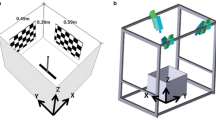Abstract
-
1.
The head-bobbing rhythm previously reported in pigeons Columba livia during approximately level landing flights also occurs in upwards landing flights. This finding strengthens the evidence that head-bobbing in flight is linked specifically to approach to a landing target, and that the behaviour has a visual function.
-
2.
In both level and upwards flights, head-bobbing arises from an oscillating flexion and extension of the neck. Rhythms in translation and rotation of the body do not make a detectable contribution to head-bobbing.
-
3.
Head-bobbing occurs at the same frequency as the wingbeat cycle and in a fixed phase relationship to it.
-
4.
The orientation of the head relative to the horizontal is correlated with the trajectory of upwards approach to a perch. In contrast to downwards landing flights, this relationship cannot have the function of keeping the perch in focus during landing. It is proposed instead that it enables the head to be bobbed along the axis which maximizes amplification of optic flow.
Similar content being viewed by others
References
Aulie A (1983) The fore-limb muscular system and flight. In: Abs M (ed) Physiology and behaviour of the pigeon. Academic Press, London, pp 117–129
Davies MNO, Green PR (1988) Head-bobbing during walking, running and flying: relative motion perception in the pigeon. J Exp Biol 138:71–91
Davies MNO, Green PR (1990) Flow-field variables trigger landing in hawk but not in pigeons. Naturwissenschaften 77:142–144
Dunlap K, Mowrer OH (1930) Head movements and eye functions of birds. J Comp Psychol 11:99–113
Elshoud GCA, Zweers GA (1987) Avian cranio-cervical systems. Part 3: Robot kinematics for cervical systems. Acta Morphol Neerl-Scand 25:235–260
Erichsen JT, Hodos W, Evinger C, Bessette BB, Phillips SJ. (1989) Head orientation in pigeons: postural, locomotor and visual determinants. Brain Behav Evol 33:268–278
Fitzke FW, Hayes BP, Hodos W, Holden AL (1985) Refractive sectors in the visual field of the pigeon eye. J Physiol (Lond) 369:33–44
Friedman MB (1975) How birds use their eyes. In: Wright P, Caryl PG, Vowles DM (eds) Neural and endocrine aspects of behaviour in birds. Elsevier, Amsterdam, pp 181–204
Frost BJ (1978) The optokinetic basis of head-bobbing in the pigeon. J Exp Biol 74:187–195
Green PR, Davies MNO, Thorpe PH (1992) Head orientation in pigeons during landing flight. Vision Res 32:2229–2234
Hayes BP, Hodos W, Holden AL, Low JL (1987) The projection of the visual field upon the retina of the pigeon. Vision Res 27:31–40
Heidweiller J, Van der Leeuw AHJ, Zweers GA (1992) Cervical kinematics during drinking in developing chickens. J Exp Zool 262:135–153
Hodos W, Erichsen JT (1990) Lower-field myopia in birds: an adaptation that keeps the ground in focus. Vision Res 30:653–658
Jenkins GM, Watts DG (1968) Spectral analysis and its applications. Holden-Day, San Francisco
Lee DN, Davies MNO, Green PR, van der Weel FR (1993) Visual control of velocity of approach by pigeons when landing. J Exp Biol 180:85–104
Martin GR, Young SR (1983) The retinal binocular field of the pigeon (Columba livia: English Racing Homer). Vision Res 23:911–915
Zweers GA, Vanden Berge JC, Koppendraier R (1987) Avian cranio-cervical systems. Part 1: Anatomy of the cervical column in the chicken (Callus gallus). Acta Morphol Neerl-Scand 25:131–155
Author information
Authors and Affiliations
Rights and permissions
About this article
Cite this article
Green, P.R., Davies, M.N.O. & Thorpe, P.H. Head-bobbing and head orientation during landing flights of pigeons. J Comp Physiol A 174, 249–256 (1994). https://doi.org/10.1007/BF00193791
Accepted:
Issue Date:
DOI: https://doi.org/10.1007/BF00193791




